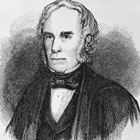William MacGillivray
William MacGillivray was an exceedingly talented man. So why have most people today never heard of him?

William MacGillivray (1796-1851).
MacGillivray was a leading Scottish naturalist, an expert on birds and a gifted artist. He wrote many scientific papers and books, and revolutionised the teaching of natural history. He also produced a small but wonderful collection of watercolours depicting birds, fish and mammals. Despite his enormous contribution to the life sciences and art, circumstances conspired to leave this genius largely unrecognised.
Work
The artist as a young man
MacGillivray was raised in rural surroundings on the Scottish island of Harris. He received a good school education and attended university in Aberdeen. From early on, he preferred exploring the outdoors to studying inside. He gained expert knowledge of the animals and plants of the Scottish Highlands by going on solo field trips, often walking hundreds of miles.
Academic life
MacGillivray progressed through his dedication to his work, gaining experience and honing his skills. In 1823 he became assistant to the professor of natural history at Edinburgh University. Later, the Royal College of Surgeons in Edinburgh appointed him curator of their museum. In 1841 his talents were recognised when he secured the position of professor of natural history at Marischal College, Aberdeen. Here he transformed the way students were taught by taking them out into the wild and inspiring them with his passion for nature.
Although adored by his students, MacGillivray did not endear himself to everybody. With an absolute conviction in his own abilities, he tended to be provocative and outspoken. He often condemned scientists who examined specimens without ever seeing the creature in its natural habitat. These 'cabinet naturalists' included some of the most influential scientists of the day. But they would have their revenge.
'To those really desirous of information respecting our native species, I would say, let us betake ourselves to the fields and woods; let us traverse the hills and valleys together; let us there study our favourites, pursue them from brake to bush.' Letter to a colleague
'I had been led to think that I had occasionally been somewhat rude or at least blunt, in my criticism; but I do not perceive wherein. I have much erred in that respect, and I feel no inclination to apologise..' From the preface to a History of British Birds
Books and birds
MacGillivray wrote numerous books and scientific papers. These spanned a wide range of topics from the lives of plants to biographies of eminent zoologists. He made a major contribution to the Ornithological Biography, written by the famous American bird expert JJ Audubon.
MacGillivray's most accomplished work was A History of British Birds. Extremely detailed and accurate, this was the most comprehensive work on birds available in Britain at the time. When it was published, those 'cabinet scientists' that MacGillivray had offended gave it appalling reviews. They criticised it for being too scientific and without appeal for the general public (its intended audience). As a consequence, the book did not receive the acclaim it deserved.
'I can look upon my work without much regard to the opinions which contemporary writers may form of it, assured that what is useful in it will not be forgotten...' From the preface to a History of British Birds
MacGillivray's art
MacGillivray also became an accomplished artist, creating stunning portraits of birds and plants. His scientific observations of animals in their natural habitats enabled him to paint with meticulous detail and capture the majesty of his subjects. Wildlife artists of the day often portrayed live animals looking frozen and artificial. MacGillivray, the innovator, painted his subjects in all their natural beauty.
An unrecognised genius
Despite his prodigious output and the respect he won from his students, the name MacGillivray is not well known today. He received little recognition due to his abrasive personality and because of his financial situation, which prevented him from funding the publication of his watercolours.
In 1892 his son, Paul Howard MacGillivray, presented 214 of his paintings to the Museum.
Timeline
| 1796 | Born 25 January, Aberdeen, Scotland. |
|---|---|
| 1801 | Britain becomes the United Kingdom of Great Britain and Ireland. |
| 1815 | Graduated from the University of Aberdeen with a general MA. |
| 1823 | Became assistant to the professor of natural history at Edinburgh University. |
| 1830 | Publication of Lives of Eminent Zoologists from Aristotle to Linnaeus and A Systematic Arrangement of British Plants. |
| 1831 | Appointed curator of the museum of the Royal College of Surgeons in Edinburgh. |
| 1831–39 | Audubon publishes his Ornithological Biography to which MacGillivray has contributed. |
| 1832 | Publication of The Travels and Researches of Alexander von Humboldt. |
| 1837 | Victoria becomes Queen. |
| 1837–52 | Publication of A History of British Birds in five volumes. |
| 1838 | Publication of A History of British Quadrupeds. |
| 1840 | Publication of A Manual of Botany, Comprising Vegetable Anatomy and Physiology. |
| 1840–42 | Publication of A Manual of British Ornithology . |
| 1841 | Appointed professor of natural history at Marischal College, Aberdeen. |
| 1852 | Died 8 September, Aberdeen, Scotland. |
| 1855 | Posthumous publication of The Natural History of Deeside and Braemar. |
| 1892 | MacGillivray's paintings are presented to the Natural History Museum. |